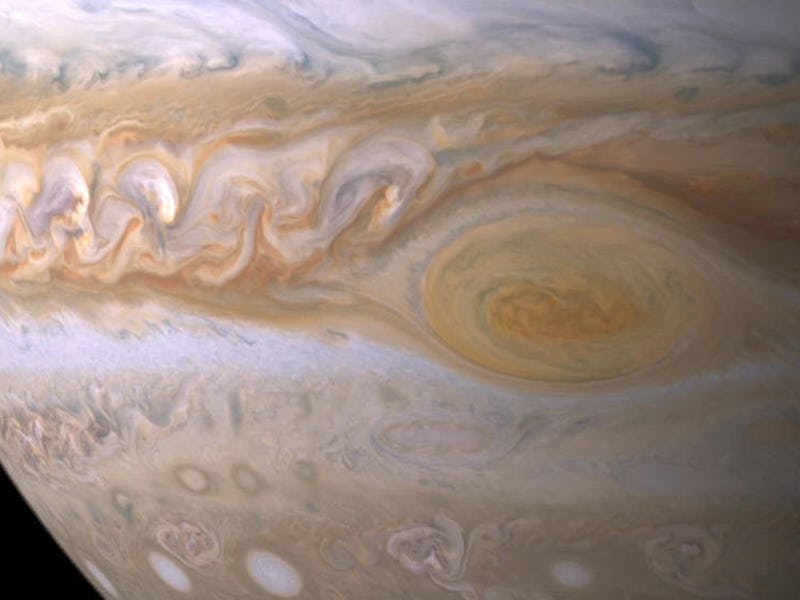Without Jupiter, Earth Would Be a Hellish, Uninhabitable World
Scientists find hard evidence that Jupiter was born early, allowing our humble, perfect planet to form.

Jupiter, King of the Planets, changed everything.
Scientists found that the gas giant wasted little time in becoming a dominant, massive planetary player in our solar system, a mere million years into our solar system’s existence. Without Jupiter’s influence, it’s unlikely that our hospitable planet could have formed tens of millions of years after Jupiter meshed together.
The evidence for Jupiter’s early birth lies in the meteorites scattered all over Earth, according to research published this week in Proceedings of the National Academy of Sciences. These space rocks, which also formed early on and come in two distinct varieties, didn’t intermix as everything in the chaotic, young solar system was gluing together, because something enormous kept their unique ingredients apart. The most plausible culprit, say scientists, was Jupiter.
“Jupiter was a massive barrier,” Thomas Kruijer, the study’s lead author and geochemist at the Lawrence Livermore National Laboratory, tells Inverse. “If Jupiter was in between, the flux of material would stop.”
Jupiter is as wide as 11 Earths.
Separated by the young though colossal Jupiter, this hot, swirling material formed into two distinct populations of massive, rocky bodies. These two species of rocks eventually intermixed and, over billions of years, have been smashed apart by eons of collisions. Their remnants are flung from the asteroid belt (what Kruijer calls the graveyard of these rocky, planetary bodies), often plunging down to Earth. Kruijer and his team dated both varieties of these primordial space rocks by measuring their amounts of tungsten isotopes, which decay and change over time, providing an indication of age. The team found that the two types of rocks existed at the same time, but because Jupiter’s early birth prevented their ingredients from intermixing, they formed into two distinct class of meteorites — respectively called carbonaceous and non-carbonaceous meteorites.
If Jupiter didn’t have such an abrupt birth, unhindered masses of cosmic material could have been heaped into the inner solar system — home to the relatively small planets of Mercury, Venus, Earth, and Mars — and instead created super-Earths, or a large gaseous planet like Neptune, explains Kruijer.
This would likely doom the creation of our perfectly-sized planet, where most everything aligned and life flourished, from the T. rex, to the hippo, to Neanderthals.
“I would say it’s possible that if Jupiter wasn’t there, that a planet like Neptune could be around Earth’s orbit, and there would be no habitable planets in our solar system,” says Kruijer. “A habitable Earth is dependent upon Jupiter’s presence early on.” However, Kruijer acknowledges that this isn’t a guaranteed truth — who knows what would have actually transpired.
But simply put, a planet twice the size of Earth, or larger, probably wouldn’t have been conducive to life. “There’s a delicate balance of factors that makes Earth habitable,” says Kruijer, so any deviation would have thrown a wrench in the perfect unfolding of events that formed Earth.
NASA Juno spacecraft recently sent back pictures of Jupiter's swirling, terrifying storm.
For instance, a super-Earth would attract more matter and have a thicker atmosphere, similar to the gas giants in our atmosphere, which are filled with noxious gases and are unquestioningly hostile to life. Or, perhaps, a rocky, Earth-like planet would have formed, but a thicker atmosphere could have resulted in a perpetual runaway greenhouse gas effect, creating the hostile pizza oven-like temperatures found on Venus.
Jupiter may not be the sole reason why you’re a sentient being reading this article on a temperate, tree-filled planet, but “Jupiter at least played a key role,” says Kruijer. “It was definitely important, and it was there from early on.”
Abstract: The age of Jupiter, the largest planet in our Solar System, is still unknown. Gas-giant planet formation likely involved the growth of large solid cores, followed by the accumulation of gas onto these cores. Thus, the gas-giant cores must have formed before dissipation of the solar nebula, which likely occurred within less than 10 My after Solar System formation. Although such rapid accretion of the gas-giant cores has successfully been modeled, until now it has not been possible to date their formation. Here, using molybdenum and tungsten isotope measurements on iron meteorites, we demonstrate that meteorites derive from two genetically distinct nebular reservoirs that coexisted and remained spatially separated between ∼1 My and ∼3–4 My after Solar System formation. The most plausible mechanism for this efficient separation is the formation of Jupiter, opening a gap in the disk and preventing the exchange of material between the two reservoirs.As such, our results indicate that Jupiter’s core grew to ∼20 Earth masses within <1 My, followed by a more protracted growth to ∼50 Earth masses until at least ∼3–4 My after Solar System formation. Thus, Jupiter is the oldest planet of the Solar System, and its solid core formed well before the solar nebula gas dissipated, consistent with the core accretion model for giant planet formation.